Here’s the thing: astrology has ditched dusty newspaper columns for AI-driven mobile screens, and apps like Astra show people now check planetary insights as often as the weather.
Build an app like Astra and you’re not spinning out another horoscope widget, you’re creating a sticky, subscription-friendly product that slides straight into the booming self-care economy.
Analysts expect digital-astrology revenue to more than double by 2029, so early movers can still scoop up users before acquisition costs soar and the field crowds in.
So, if you are into understanding how to build an astrology app like Astra, from first sketch to steady revenue, we are here with you.
We’ll cover the must-have features, tech stack options, and price tags, then flag the trends lining up next so your roadmap stays sharp long after launch.
Key Takeaways:
Now is the best window to develop an app like Astra: the digital-astrology market is projected to double, from $4.75 billion in 2025 to nearly $10 billion by 2029.
Nail four must-have hooks first, AI birth-chart readings, compatibility maps, daily push rituals and an interactive feed before adding shiny extras like AR sky overlays.
Follow a proven build path: research the gap, shape personas, map revenue streams, blueprint features, craft intuitive UX, choose a scalable stack to create an app like Astra.
The cost to create an app like Astra ranges roughly from $20,000 to $60,000+ for AI narratives, AR constellations and live-consultation modules.
Future-proof your roadmap with gamified quests, voice horoscopes, wellness-app tie-ins and blockchain data trust, then lean on a specialist team like JPLoft to keep releases rolling.
What Is an Astra App?
An Astra App is a next-generation astrology companion that blends precise ephemeris data with AI-driven copy to deliver deeply personalized birth-chart analyses, daily horoscopes, and compatibility reports.
It swaps static text for interactive feeds, swipeable relationship maps, push-notification rituals keyed to moon phases, and even AR sky overlays, so every insight feels custom-made.
Built on a mix of modern NLP models, reliable integration, and smooth cross-platform frameworks, an Astra App turns cosmic data into shareable, habit-forming experiences.
If you’re ready to capture this magic cycle every morning, it’s time to create an astrology app.
Astrology App Market Stats
The astrology app market stats show the market is booming as seekers look for on-demand cosmic guidance:
-
- Global digital astrology revenue hit $4.75 billion in 2025.
- Projected to nearly double to $9.91 billion by 2029 at a 20 % CAGR
- Astra-style apps average 11 weekly opens per user, outpacing many lifestyle categories
- Subscription-based models account for over 60 % of total in-app revenue
These figures highlight a sky-high demand; now is the perfect moment to start an online astrology business.
Why Should You Invest in Astra-like App Development in 2025?
Astrology’s leap from magazine pages to mobile screens is more than just a trend; it's a shift in how millions seek meaning, entertainment, and daily guidance.
Apps like Astra blend tradition with innovation, offering interactive, hyper-personalized experiences.
The opportunity to develop an app like Astra has never been more promising.
Here’s why:
1. Revenue Diversity
Astrology apps make money far beyond ad banners.
Tiered subscriptions deliver predictable MRR, live video consultations command premium per-minute fees, and curated crystal kits or zodiac journals extend the brand offline.
Mixing these streams cushions churn shocks and attracts investors hunting for healthy lifetime-value multiples.
2. Low Bar For Niche Leaders
Many online astrology startups fail by chasing everyone; sharp positioning still wins.
A laser-focused USP, relationship compatibility, lunar wellness rituals, or immersive AR in astrology apps can carve out untouched white space.
It lets small teams compete head-on with giants without needing blockbuster marketing budgets.
3. Growing User Base
The number of astrology app users climbs each year. They span every age group, from Gen Z to boomers.
They stretch across continents, crossing borders with ease. Together, they form a global community hungry for guidance and entertainment.
4. Personalized Wellness
Today’s users want experiences tailored to their birth charts and personal journeys.
Advanced features like daily horoscopes, AI-driven predictions, and compatibility readings are now essential.
So, these are some of the reasons why you should build a horoscope app like Astra.
Let’s talk about features that can separate you from the rest:
Top Features to Build an App Like Astra
Astra nails engagement with a defined set of astrology app features; Nail these pillars first before layering on extra bells and whistles.
|
Feature |
Why It Hooks Users |
Priority |
Implementation Tip |
|
AI-Driven Birth-Chart Readings |
Feels ultra-personal, every insight reads like it was custom-written for you. |
Must-have |
Fine-tune your NLP model on real astrologer scripts. |
|
Compatibility & Relationship Map |
Sparks social sharing and keeps people coming back to compare charts. |
High |
Offer swipable or drag-and-drop comparisons. |
|
Daily Push Alerts & Rituals |
Builds streaks and reminds users to check in, boosting retention. |
Must-have |
Tie notifications to local sunrise and moon phases. |
|
Interactive Horoscope Feed |
Let users scroll, bookmark, and comment on each sign’s forecast. |
High |
Cache today’s horoscopes in Redis for instant load times. |
|
In-App Community & Chat |
Creates a sense of belonging and drives viral invites. |
Medium |
Integrate a lightweight chat API like Stream or Twilio. |
|
Augmented Reality Sky Map |
Delivers “wow” moments by overlaying constellations on the real sky. |
Medium |
Use Unity’s AR Foundation for cross-platform support. |
|
Customization & Themes |
Empowers users to pick colour palettes and font styles, deepens ownership. |
Low |
Store preferences in the user profile and apply via CSS variables. |
Start here when you build an app like Astra; lock these features in, then experiment with premium add-ons and niche twists.
How to Create an App Like Astra?
Ever wondered how to create an app like Astra that users check before their morning coffee?
It starts with a clear vision, the right mix of features, and a launch plan that shines like a comet.
Follow these seven steps to build an app like Astra that keeps people hooked on daily cosmic insights.
Step 1: Ideation & Market Research
Before you develop an app like Astra, dive into the data.
Scan app stores for top horoscopes, note their ratings and gaps, and read user reviews for pain points.
Spend a week sketching three different angles of daily rituals, compatibility matches, or AR constellations and validate with quick surveys. That early curiosity weeds out dead ends before you write a line of code.
Step 2: User Persona Development
When you create an app like Astra, empathy is your secret weapon.
Draft two to three personas: a busy professional seeking quick cosmic tips, a spiritual seeker craving deep moon rituals, and a social butterfly sharing compatibility stats.
Give them names, backstories, and one burning question they’ll ask your app. That human detail steers every UI choice and marketing message.
Step 3: Business Model & Monetization Planning
To make an app like Astra sustainable, sketch revenue before features.
Compare subscription tiers (monthly horoscopes vs. premium compatibility packs), per-minute live chat fees, and branded merch boxes.
Calculate your break-even point on each model, then pick two to test in beta. A clear money map keeps your dream from drifting into a money pit.
Step 4: Feature Blueprinting
Now that you know who you’re building for and how you’ll earn, outline the heartbeat of your product.
List must-have features, AI-driven birth-chart readings, daily push rituals, and social compatibility shares. You can number each by impact and effort.
This Feature Blueprint becomes your backlog, so you build an app like Astra in tidy sprints, not feature-chaos.
Step 5: Designing the User Experience
As you know, great cosmic guides feel intuitive.
Wireframe your signup flow: two taps to enter birth data, one tap to see today’s horoscope. Sketch feed layouts that let users scroll through rituals or compatibility cards.
Add playful touches, subtle star animations, themed colour palettes and test clickable prototypes on real users. A polished UX is your promise that you’ll build an astrology app like Astra that people actually love.
Step 6: Tech Stack
Time to choose the right astrology app tech stack.
Turn those sketches into code with the right tools. Flutter or React Native covers iOS and Android in one go.
On the backend, Node.js with a PostgreSQL database and Redis cache keeps charts loading instantly.
Plug in precise planetary data via Astrology API integration and feed it into OpenAI or Hugging Face for natural-language horoscopes.
Dockerize each service and deploy on AWS Fargate so your app auto-scales when a viral meme drives a sudden download surge.
Step 7: Security, Privacy, & Compliance
Without ensuring the astrology app's security, you can’t go in front of your users to launch the app.
You’re handling birth dates, times, and location, real personal data. Encrypt everything at rest (AES-256) and in transit (TLS 1.3).
Offer passkey or two-factor login, and draft a clear privacy policy that feels human, not legalese. If you create an app like Astra for Europe, nail GDPR from day one.
That care builds trust and keeps you out of data-violation headlines.
Step 8: Testing & Feedback Loops
Ship early to a select group of friends, family, or your personas in action.
Watch where they hesitate, where onboarding stalls, and which rituals get ignored.
Log crashes and performance metrics, then tighten the loop: fix bugs, tweak copy tone, and refine notification timing.
Constant app testing and feedback keep you agile and ensure your app truly lives up to “build an app like Astra.”
Step 9: Launch Your App
Your cosmic companion is ready to meet the world: time to submit an app to the App Store and launch your app to the Play Store. First, prep your final build: confirm icons, screenshots, and deep links shine.
Then, in App Store Connect, fill in your story-rich description and hit Submit for Review. Over in Google Play Console, craft a punchy headline, upload graphics, set pricing, and publish.
On launch morning, fire off teasers: “Your first star reading drops today,” and reward early adopters with a free ritual pack.
Monitor installs, retention, and crash logs, and deploy hotfixes to keep your orbit flawless.
Step 10: Continuous Improvement
An astrology app isn’t a one-off fortune cookie; it’s an evolving companion.
So, time to work on app maintenance services. It’s best to roll out weekly ritual updates, curate themed event packs for eclipses, and host live new-moon chats with guest astrologers.
Use analytics to spot engagement dips, maybe your push notifications need a reset, and test tweaks without rebuilding the whole app.
With a clear roadmap and constant star-gazing on user data, you’ll not just develop an app like Astra, you’ll keep it shining.
With the process being done, time to know about its overall cost of app development.
How Much Does it Cost to Create an App Like Astra?
Wondering what budget brings cosmic insights to life?
The cost to develop an astrology app depends on your chosen feature mix, tech stack, and polish level.
However, the Astra-like app development can go from $20,000- $60,000+. A lean MVP, daily horoscopes, birth-chart calculations, and basic push alerts can be built for around $20,000.
Step up to AI-driven narratives, AR sky overlays, compatibility maps, and live chat, and you’re looking at $60,000 or more. Investing in thoughtful design, rock-solid security, and seamless performance elevates user trust and boosts retention.
With subscription, consultation, and merchandise revenue streams, this upfront outlay often pays for itself.
Here is a table breakdown for a general overview.
|
Phase |
Time Frame |
Cost Range (USD) |
|
Discovery & Planning |
2–3 weeks |
$2,000–$5,000 |
|
UI/UX Design |
3–4 weeks |
$3,000–$8,000 |
|
Core Development |
8–10 weeks |
$8,000–$20,000 |
|
AI & API Integration |
2–4 weeks |
$3,000–$10,000 |
|
QA & Testing |
1–2 weeks |
$2,000–$5,000 |
|
Launch & Marketing Preparation |
2–3 weeks |
$2,000–$5,000 |
|
Total |
18–26 weeks |
$20,000–$60,000+ |
This is just an overview; to find out the true cost of your idea, you need to connect with the best mobile app development company.
How Astrology Apps like Astra Can Make Money?
Creating a reliable revenue engine is as vital as perfecting your cosmic UX. To build an astrology app like Astra that sustains growth, you need solid models.
Here are seven revenue streams to consider:
1] Subscription Tiers
Your astrology app monetization model often begins with tiered subscriptions.
Offer core daily horoscopes free, then unlock premium deep-dive readings or monthly ritual bundles behind a $4.99–$9.99/mo paywall.
Predictable MRR funds ongoing content updates and experimental features while keeping churn at manageable levels.
2] Pay-Per-Insight Microtransactions
Among top app monetization strategies, selling one-off insights boosts ARPU.
Price specialized reports, year-ahead forecasts or compatibility deep-dives between $2 and $10 each.
Users enjoy flexibility without ongoing commitment, and you benefit from demand spikes around eclipses or retrogrades.
3] Live Astrologer Consultations
Offer real-time video or chat sessions with certified astrologers at $1.50–$2.50 per minute.
High-margin live consultations foster trust and deepen user relationships.
Integrate secure payment flows and in-app scheduling to let seekers book one-on-one readings seamlessly.
4] Merchandise & Digital Collectibles
Branded physical goods, crystal kits, ritual candles and digital collectibles like themed NFTs open new revenue channels.
Bundled ritual boxes or exclusive digital charms deepen brand affinity. This diversification turns casual users into devoted collectors over time.
5] Sponsored Content & Affiliate Partnerships
Collaborate with wellness brands for sponsored horoscopes or product recommendations.
Affiliate links to meditation apps, crystal sellers, or yoga classes earn referral commissions.
When partner offers align with your users’ spiritual journey, you add value without eroding trust.
6] Ad-Supported Insights
For free-tier users, integrate subtle, contextually relevant ads like sponsored readings or gentle banners.
Thoughtful placement and limited frequency ensure ads enhance rather than disrupt the experience. Balanced ad loads safeguard retention while unlocking additional revenue.
With these amazing monetization models, you can clearly make money while offering a good user experience.
Now, let’s shift our attention to future trends.
Leveraging Next-Gen Trends for Apps Like Astra
Staying ahead in the crowded cosmos means weaving tomorrow’s tech into every interaction.
An app like Astra can surprise and delight by embracing innovations that deepen engagement, boost retention, and create shareworthy moments.
Here are future-facing astrology app trends to integrate now:
► Dynamic Gamification in Astrology Apps
Utilizing gamification in astrology apps can be a great idea.
By layering personalized quests, cosmic badges, and challenge-driven streaks, your app, like Astra, transforms routine horoscope checks into thrilling missions.
Smart rewards, earned for daily readings or compatibility share, drive habit loops and keep users returning for their next cosmic victory.
► Use Immersive AR in Astrology Apps
Overlay live constellations on city skylines or home ceilings to turn any space into a personal observatory.
With interactive AR in astrology app features, users unlock shareable sky tours that spark organic installs and word-of-mouth buzz.
► Leverage Artificial Intelligence
Integrate chat-driven interfaces so seekers can “ask” for their rising sign or moon forecast and receive instant, natural-language replies.
Get these features with the help of an experienced AI development company and turn every horoscope into a friendly chat.
► Voice-First Horoscope Delivery
Enable users to speak commands: “What’s my Leo compatibility today?” and hear their horoscope read aloud.
A voice-driven layer turns any smart speaker or in-app assistant into a cosmic concierge, perfect for hands-free interactions.
► Wellness Ecosystem Integration
Sync lunar rituals and seasonal prompts with sleep or fitness trackers.
When your app, like Astra, taps health data, stress levels, and sleep patterns, it delivers truly personalized routines that bridge astrology and holistic self-care.
► Blockchain-Backed Data Trust
Secure birth data and readings with decentralized identity checks and immutable ledgers.
Partnering with a blockchain development company reassures users that their personal information is protected, turning security into a standout feature and a true competitive advantage.
How JPLoft Can Help You Develop an App like Astra?
Imagine turning every zodiac reading into a viral moment that hooks users at first glance. JPLoft, the premier astrology app development company, combines deep industry insights with cutting-edge tech to build apps like Astra that feel personal and powerful.
Our team crafts AI-driven birth-chart engines, immersive AR experiences, and seamless UX flows, ensuring every tap sparkles with cosmic magic.
Whether you’re validating features, designing rituals, or scaling to millions, our clear roadmap and expertise make building an astrology companion effortless.
From concept to post-launch support, we guide you through every stellar development step.
Conclusion
Astrology’s rise onto mobile screens shows there’s more demand than ever for apps like Astra. By clearly defining your vision, nailing core features, choosing the right stack, and planning a star-worthy launch, you set yourself up for success.
Flexible monetization models, subscriptions, microtransactions, and consultations turn engagement into recurring revenue. Post-launch, steady ritual updates, analytics-driven tweaks, and community events keep your app orbiting in users’ daily routines.
At JPLoft, we guide you through every step, from ideation to maintenance.
Follow this roadmap, and you won’t just build an app like Astra; you’ll create a lasting cosmic companion users open day after day.
FAQs
A lean MVP with core horoscopes and basic API integration typically starts around $20,000. Adding AI narratives, AR sky maps, live chat, and gamification pushes budgets toward $60,000+.
Must-haves include AI-driven birth-chart readings, daily horoscope alerts, compatibility reports, and push-ritual reminders. An interactive feed with comments, bookmarks, and basic community chat rounds out the essentials before you layer on premium add-ons like live consultations or Tarot modes.
A cross-platform front end using Flutter or React Native pairs well with a Node.js backend and PostgreSQL/Redis for data and caching. Plug in precise ephemeris feeds via Astrology API integration and use OpenAI or Hugging Face for natural-language horoscope generation. Docker on AWS keeps it scalable.
Start with tiered subscriptions, free daily readings, and premium deep dives at $4.99–$9.99/month. Add pay-per-insight micro transaction speciality reports, high-margin live astrologer chats, and branded merchandise.
Treat your app as a living companion: ship weekly rituals and themed event packs, host live new-moon chats, and monitor DAU and retention. Use analytics to spot engagement dips and test tweaks. A clear roadmap for quarterly features, voice horoscopes, and NFT talisman AR extensions keeps excitement high.





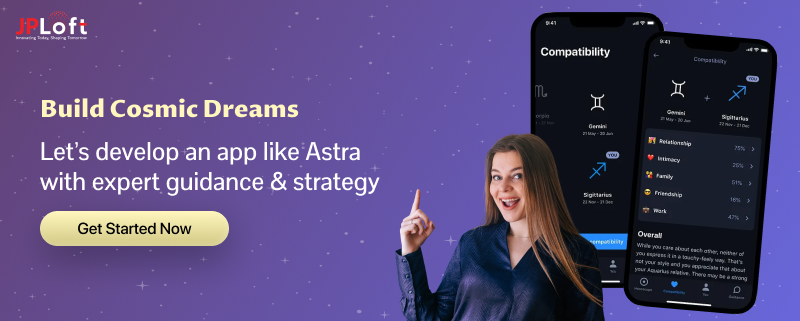
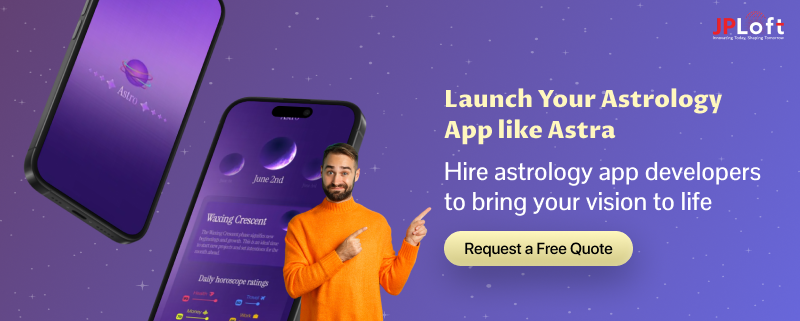

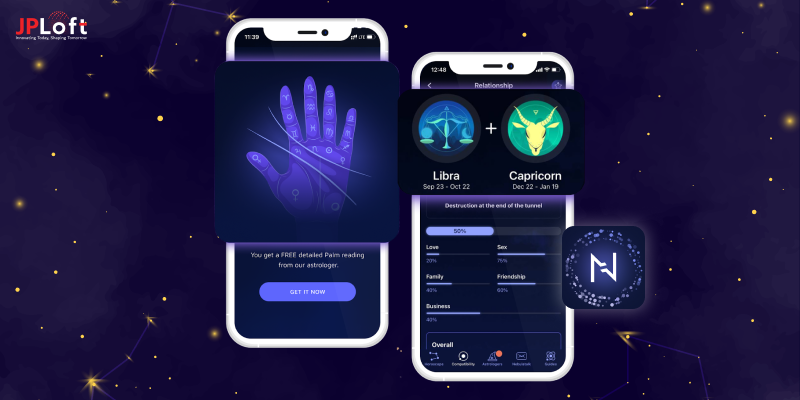
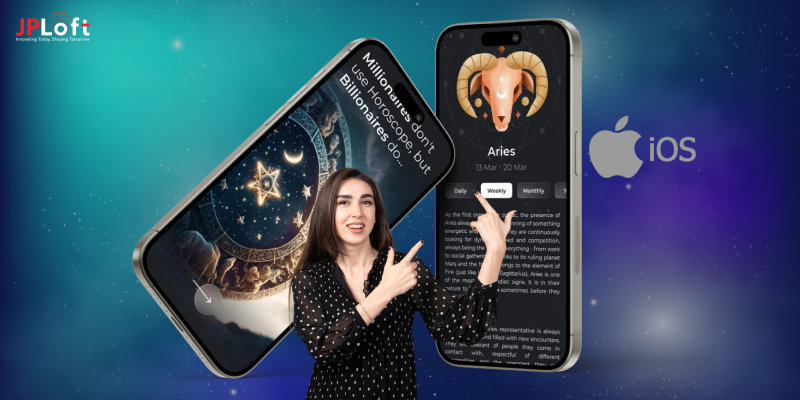
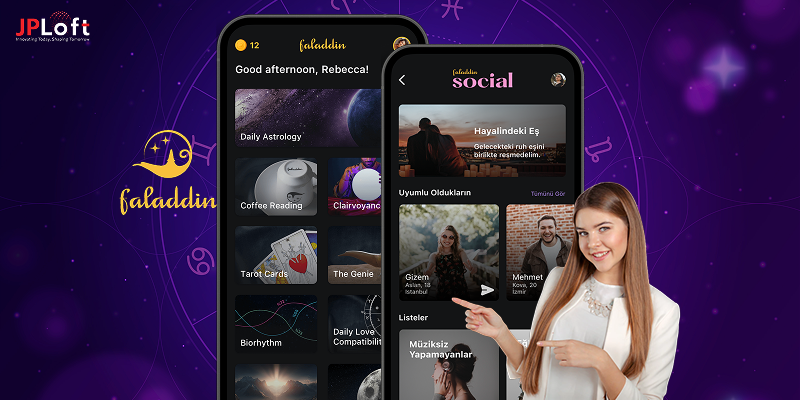


Share this blog